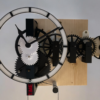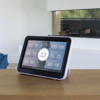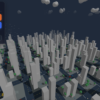
With the latest version of Augmented Reality Player for iOS v1.2.0 users can now choose geo-location as a visualization option for their projects. The Geo-location feature allows to use GPS coordinates to locate a 3D model/animation on the earth’s surface. The software then tracks the 3D model coordinates in the real space using a suitable sensor fusion technique. This makes it possible to display virtual models in the real world without any marker:
Besides support for geolocated 3D models and animations, now the Player also supports skinning and morphing animations. In addition, users can freely move virtual models in the real environment using an intuitive interface.
The Geo-localization feature extends the spectrum of visualization possibilities of the ARplugin in many application domains, including architecture, engineering and cultural heritage.
Its an interesting development and we would be keen to know the level of accuracy achieved, for rural sites and to determine a rough idea of a developments impact on a view it seems to be useful.
The iOS ARplayer v1.2.0 is available for iPad and iPhone. It can be freely downloaded from Apple’s App Store and it works in association with the latest update of ARmedia Plugin Professional v2.2. Supported products include Trimble SketchUp, Autodesk Maya and 3ds Max, Maxon Cinema4D and Nemetschek Vectorworks.
You can download the iOS ARplayer now directly from Apple’s App Store:
http://itunes.apple.com/app/
For more information see: http://www.








